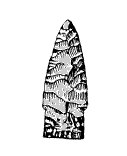

Scientists in North America first developed thermoluminescence dating of rock minerals in the 1950s and 1960s, and the University of Oxford, England first developed the thermoluminescence dating of fired ceramics in the 1960s and 1970s.During the 1970s and 1980s scientists at Simon Frasier University, Canada, developed standard thermoluminescence dating procedures used to date sediments. In 1985, they also developed optically stimulated luminescence dating techniques, which use laser light, to date sediments.
The microscopic structure of some minerals and ceramics trap nuclear radioactive energy. This energy is in constant motion within the minerals or sherds. Most of the energy escapes as heat, but sometimes this energy separates electrons from the molecules that make up the minerals or ceramics. Usually the electrons will reconnect with the molecules, but some will not. The electrons that dont reconnect eventually encounter imperfections in the microscopic structure of the ceramics or minerals, and they become trapped by these imperfections. Over time energy (in the form of more and more trapped electrons) is stored in these structural imperfections. By heating the ceramic or mineral to above 500 degrees Celcius, these trapped electrons are released, creating a flash of light called thermoluminescence. When a laser light source is used to stimulate the release of electrons, the process is called optically stimulated luminescence.
Luminescence Profile
In the process of making a ceramic vessel, the soft clay vessel must be heated in a kiln to harden it. The process of firing the vessel releases the trapped electrons (energy), and resets the thermoluminescence clock to zero. The process of accumulation of electrons (energy) and then release when heated occurs every time the ceramic vessel is reheated. What an archaeologist would be able to measure using this technique is the last time the vessel was heated above 500 degrees Celcius, either at the time the vessel was first fired or the last time it was heated if it was used as a cooking vessel. In the laboratory, the release of electrons can be induced through heating or the use of a laser beam. The intensity of the light emmisions (luminescence) can be measured to determine the amount of time that has passed since the vessel was last heated and the present laboratory heating of the vessel.
How is a Luminescence Sample Processed?
A small sample is cut out of the artifact being dated. An equivalent dose (DE) of nuclear radiation is determined for every artifact through the application of artificial doses of nuclear radiation (through heating or exposure to a laser light beam) to subsamples of the artifact to scale the signal. Next the burial dose rate (DR) is determined by measuring the radioactivity in portions of the sample grains and surrounding sediments. Lastly, the age of the sample is determined by dividing the equivalent dose by the burial dose rate (DE/DR = Age).
This method is applicable to samples that range in age from a few hundred years to several hundred thousand years.
The Limitations of Luminescence Dating
Using this technique, almost any rock mineral or ceramic sample can be directly dated. However, it works best when dating heated grains in ceramics, obsidian, burned flint, and burned sediments.
Links
The Dalhousie Thermally and Optically Stimulated Luminescence and ESR Laboratory
The Research Laboratory for Archaeology and the History of Art, Oxford University
Aberystwyth Luminescence Dating Laboratory
The Sheffield Centre for International Drylands Research (SCIDR), England
Archaeometry Research Group Heidelberg, Germany
The University of Washington Luminescence Dating Laboratory
References
Aitken, Martin J. 1985.
Thermoluminescence Dating.
Aitken, Martin J. (in press) Optical Dating: A Review for Non-Specialists.
Quaternary Science Reviews
Ollerhead, Jeff, David J. Huntley, and Glenn W. Burger. 1994. Luminescence Dating of the Buctouche Spit, New Brunswick.
Canadian Journal of Earth Sciences
31: 523-531.
|
|
|
|